Welcome aboard the Cardinal. -- one of the most spectacular train rides in America, through the overwhelming beauty of Virginia's Blue Ridge and along the wild white water of West Virginia's New River Gorge, where you'll be treated to marvelous scenery you can see only from the Cardinal. During the summer months, a U.S. Forest Ranger boards your train to provide informative commentary about the sights along the way.
All of us at Amtrak are proud to have you aboard today, and want to ensure your trip is everything you want it to be in train travel. If you have any questions, please do not hesitate to ask one of our friendly on-board service staff.
From the flash of Broadway, the monuments of the nation’s capital to the City of Big Shoulders, the Cardinal takes you through historic towns, scenic landscapes and unparalleled natural wonders on its fabulous journey south and west through America’s mid-Atlantic, southeast and heartland. On board the Cardinal, you will experience the comfort and relaxation of train travel while viewing spectacular scenery. We are happy to have you aboard today and want to ensure your trip is everything you want it to be. If there is anything that can be done to make your trip more enjoyable, please do not hesitate to call upon any Amtrak employee.
All of us at Amtrak are proud to have you aboard today, and want to ensure your trip is everything you want it to be in train travel. If you have any questions, please do not hesitate to ask one of our friendly on-board service staff.
From the flash of Broadway, the monuments of the nation’s capital to the City of Big Shoulders, the Cardinal takes you through historic towns, scenic landscapes and unparalleled natural wonders on its fabulous journey south and west through America’s mid-Atlantic, southeast and heartland. On board the Cardinal, you will experience the comfort and relaxation of train travel while viewing spectacular scenery. We are happy to have you aboard today and want to ensure your trip is everything you want it to be. If there is anything that can be done to make your trip more enjoyable, please do not hesitate to call upon any Amtrak employee.
HOST RAILROADS are the freight and commuter railroads that Amtrak contracts with to operate Amtrak passenger trains. The Cardinal operates between New York and Washington on Amtrak, between Washington and Alexandria on CSX Transportation, between Alexandria and Culpeper on Norfolk Southern, between Culpeper and Clifton Forge on Buckingham Branch, between Clifton Forge and Dyer on CSX Transportation, and between Dyer and Chicago on Norfolk Southern.
 Commodore Barry Bridge spans the Delaware River between Bridgeport, N.J. and Chester, Pa. At 1,644 ft., it is the fourth longest cantilever bridge in the world.
Commodore Barry Bridge spans the Delaware River between Bridgeport, N.J. and Chester, Pa. At 1,644 ft., it is the fourth longest cantilever bridge in the world. Marcus Hook calls itself the “Cornerstone of Pennsylvania.” Set alongside the Delaware River, it provided the setting for the 2005 film One Last Thing about a teen with a rare, terminal form of cancer who wished only for a date with a supermodel.
Marcus Hook calls itself the “Cornerstone of Pennsylvania.” Set alongside the Delaware River, it provided the setting for the 2005 film One Last Thing about a teen with a rare, terminal form of cancer who wished only for a date with a supermodel.
Pennsylvania/Delaware State Line
 Delaware Memorial Bridge is visible downriver and connects Delaware with New Jersey. Its eight lanes span the world’s longest twin suspension bridge.
Delaware Memorial Bridge is visible downriver and connects Delaware with New Jersey. Its eight lanes span the world’s longest twin suspension bridge.The Delaware Memorial Bridge is the southernmost fixed vehicular crossing of the Delaware River and the only fixed vehicular rossing between Delaware and New Jersey. However, at Fort Mott, N.J., there is a small amount of land on the New Jersey side of the river that is part of the State of Delaware, and thus there are pedestrian crossings in between those states, but not spanning the river. See it here.
 WILMINGTON experienced high growth in jobs and office construction in the 1980's after passage of laws liberalizing bank governance within the state. Many international banks have operations in the city, especially credit card operations. The historic train station was built in 1908 by the former Pennsylvania Railroad. Notables from Wilmington include actress Valerie Bertinelli, musician Cab Calloway and commentator Bill Press.
WILMINGTON experienced high growth in jobs and office construction in the 1980's after passage of laws liberalizing bank governance within the state. Many international banks have operations in the city, especially credit card operations. The historic train station was built in 1908 by the former Pennsylvania Railroad. Notables from Wilmington include actress Valerie Bertinelli, musician Cab Calloway and commentator Bill Press.  Newark (pronounced NU-ARK) was founded in 1694. During the Revolutionary War, legend has it that the Stars and Stripes were first flown at the Battle of Cooch’s Bridge outside of Newark. Today, it is home to the University of Delaware, with world class programs in business, chemical engineering, chemistry and biochemistry. Its central area is compact, walkable and lively, due in arge part to university students. Edgar Allan Poe is said to have written parts of “The Raven” while staying at the inn on Main Street.
Newark (pronounced NU-ARK) was founded in 1694. During the Revolutionary War, legend has it that the Stars and Stripes were first flown at the Battle of Cooch’s Bridge outside of Newark. Today, it is home to the University of Delaware, with world class programs in business, chemical engineering, chemistry and biochemistry. Its central area is compact, walkable and lively, due in arge part to university students. Edgar Allan Poe is said to have written parts of “The Raven” while staying at the inn on Main Street.
Delaware/Maryland State Line
 Elkton marks the head of navigation on the Elk River, which flows into nearby Chesapeake Bay. The town was once famous as a place for eloping couples to marry.
Elkton marks the head of navigation on the Elk River, which flows into nearby Chesapeake Bay. The town was once famous as a place for eloping couples to marry.
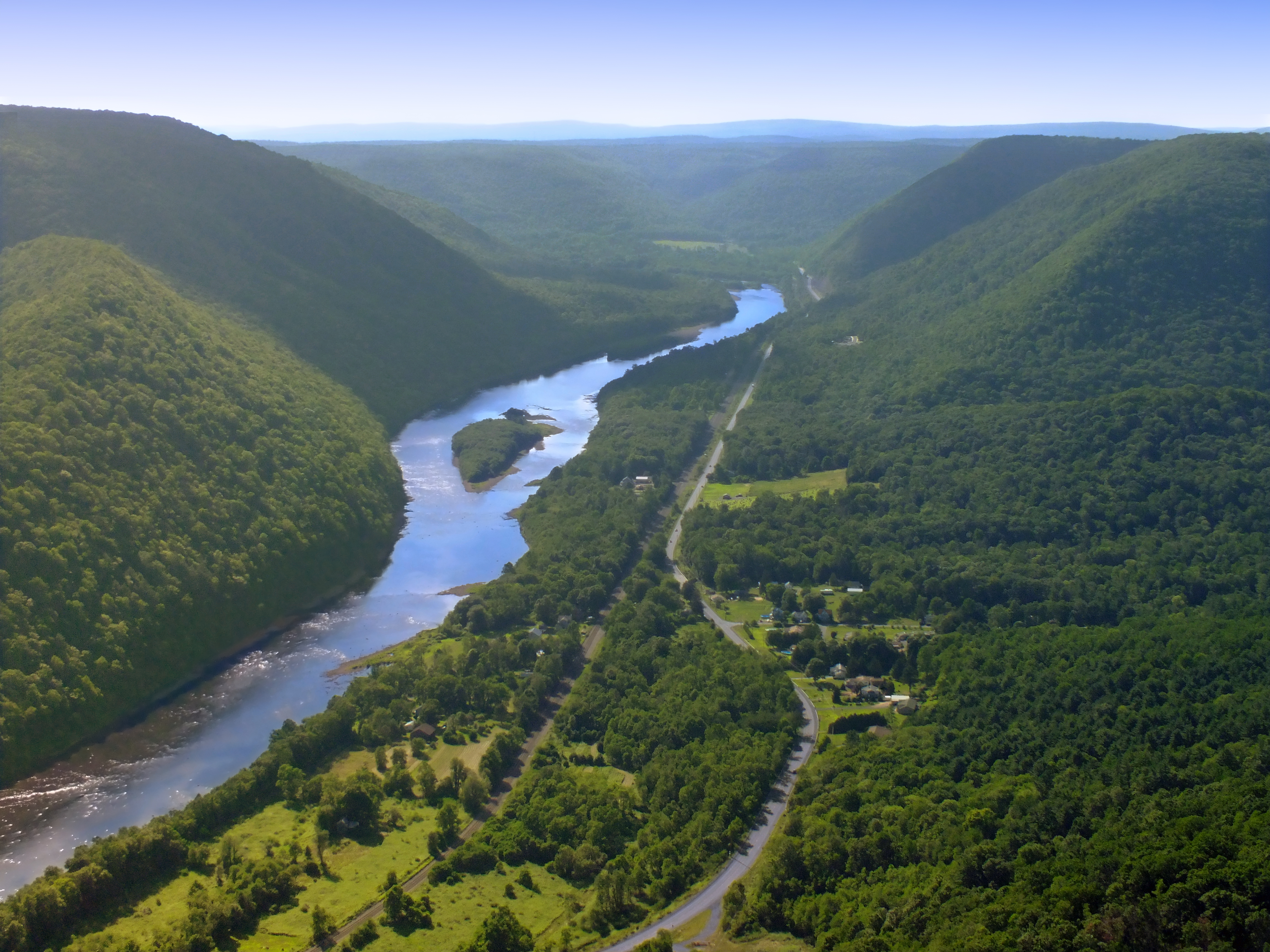 Susquehanna River is the longest river on the east coast and provides half of the freshwater inflow for the Chesapeake. Geologically, it is regarded as extremely ancient. In 1979, it was the scene of the Three Mile Island nuclear power accident near Harrisburg.
Susquehanna River is the longest river on the east coast and provides half of the freshwater inflow for the Chesapeake. Geologically, it is regarded as extremely ancient. In 1979, it was the scene of the Three Mile Island nuclear power accident near Harrisburg.  Aberdeen is home to the U.S. Army’s Aberdeen Proving Ground, established by Congress in 1918. Baltimore Orioles legend Cal Ripkin, Jr. hails from Aberdeen.
Aberdeen is home to the U.S. Army’s Aberdeen Proving Ground, established by Congress in 1918. Baltimore Orioles legend Cal Ripkin, Jr. hails from Aberdeen.  BALTIMORE is a major seaport founded in 1706 and the largest city in Maryland. Its Inner Harbor is a successful example of the city’s ambitious renewal effort. It is named after Lord Baltimore, founding proprietor of the Maryland Colony. Francis Scott Key, a Maryland lawyer, wrote the Star Spangled Banner here, a recounting of the British attack on the harbor during the War of 1812. Baltimore exhibits examples of architecture from periods ranging over two centuries. Oriole Park at Camden Yards is considered to be the most beautiful “retro” style baseball park in the major leagues. One of Amtrak’s eight busiest stations, the city is home to author Tom Clancy and Olympian Michael Phelps.
BALTIMORE is a major seaport founded in 1706 and the largest city in Maryland. Its Inner Harbor is a successful example of the city’s ambitious renewal effort. It is named after Lord Baltimore, founding proprietor of the Maryland Colony. Francis Scott Key, a Maryland lawyer, wrote the Star Spangled Banner here, a recounting of the British attack on the harbor during the War of 1812. Baltimore exhibits examples of architecture from periods ranging over two centuries. Oriole Park at Camden Yards is considered to be the most beautiful “retro” style baseball park in the major leagues. One of Amtrak’s eight busiest stations, the city is home to author Tom Clancy and Olympian Michael Phelps. NEW CARROLLTON is a suburban stop for Amtrak’s Northeast Corridor service, situated alongside the eastern terminus of the Washington Metrorail’s Orange Line. Lying just inside the famous Washington Capital Beltway, it is named for a delegate to the Continental Congress and signer of the Declaration of Independence, Charles Carroll.
NEW CARROLLTON is a suburban stop for Amtrak’s Northeast Corridor service, situated alongside the eastern terminus of the Washington Metrorail’s Orange Line. Lying just inside the famous Washington Capital Beltway, it is named for a delegate to the Continental Congress and signer of the Declaration of Independence, Charles Carroll.
Maryland/DC Border
 WASHINGTON, DC is the nation’s capital, founded in 1790. In addition to all three branches of the federal government, it houses 172 foreign embassies and the headquarters of the World Bank, International Monetary Fund, Organization of American States, Inter-American Development Bank, Pan American Health Organization, many trade unions, lobbying groups and professional associations. It is also home to numerous museums and monuments, and parks such as Rock Creek, Chesapeake and Ohio Canal, National Mall, Theodore Roosevelt Island and Anacostia. Washington is one of only 13 cities in the U.S. with teams representing all four major sports; its Washington Redskins have won three professional league championships. Several notable universities, including Georgetown, American, George Washington and Catholic are in Washington. Union Station, which celebrated its centennial in 2008, is a top tourist attraction. We depart the city from a tunnel under the Capitol, affording us a sweeping view of “official” Washington. Visible soon is the Bureau of Engraving and Printing, where all currency and postage stamps are produced. The Washington Monument dominates the skyline, and the Jefferson Memorial – modeled after the third president’s home at Monticello – can be seen astride the Tidal Basin, ringed by Japanese cherry trees.
WASHINGTON, DC is the nation’s capital, founded in 1790. In addition to all three branches of the federal government, it houses 172 foreign embassies and the headquarters of the World Bank, International Monetary Fund, Organization of American States, Inter-American Development Bank, Pan American Health Organization, many trade unions, lobbying groups and professional associations. It is also home to numerous museums and monuments, and parks such as Rock Creek, Chesapeake and Ohio Canal, National Mall, Theodore Roosevelt Island and Anacostia. Washington is one of only 13 cities in the U.S. with teams representing all four major sports; its Washington Redskins have won three professional league championships. Several notable universities, including Georgetown, American, George Washington and Catholic are in Washington. Union Station, which celebrated its centennial in 2008, is a top tourist attraction. We depart the city from a tunnel under the Capitol, affording us a sweeping view of “official” Washington. Visible soon is the Bureau of Engraving and Printing, where all currency and postage stamps are produced. The Washington Monument dominates the skyline, and the Jefferson Memorial – modeled after the third president’s home at Monticello – can be seen astride the Tidal Basin, ringed by Japanese cherry trees.
DC/Virginia Border
 Potomac River As we cross, the Pentagon is visible on the Virginia side and Arlington National Cemetery is just beyond. We now pass Crystal City, an office and hotel complex. The river, 383 miles long, forms a part of the borders between Maryland, Washington, Virginia and West Virginia. Known as “The Nation’s River,” it is rich in history and heritage. George Washington was born in, surveyed and spent most of his life within the Potomac Basin. Its watershed links coal miners in upstream West Virginia, urban residents in the District of Columbia and watermen in Virginia’s Northern Neck.
Potomac River As we cross, the Pentagon is visible on the Virginia side and Arlington National Cemetery is just beyond. We now pass Crystal City, an office and hotel complex. The river, 383 miles long, forms a part of the borders between Maryland, Washington, Virginia and West Virginia. Known as “The Nation’s River,” it is rich in history and heritage. George Washington was born in, surveyed and spent most of his life within the Potomac Basin. Its watershed links coal miners in upstream West Virginia, urban residents in the District of Columbia and watermen in Virginia’s Northern Neck.  ALEXANDRIA and its historic center, Old Town, is a mostly high income suburb of Washington, largely populated by professionals working in federal civil service, the military, or for one of the private companies contracting to provide service to the federal government. Established in 1695, it was ceded in 1846 to the U.S. Government to form the District of Columbia, and retro ceded to Virginia in 1846 when the District of Columbia was reduced in size to exclude that portion south of the Potomac River. Market Square in Old Town is the oldest continuously operating marketplace in the U.S.
ALEXANDRIA and its historic center, Old Town, is a mostly high income suburb of Washington, largely populated by professionals working in federal civil service, the military, or for one of the private companies contracting to provide service to the federal government. Established in 1695, it was ceded in 1846 to the U.S. Government to form the District of Columbia, and retro ceded to Virginia in 1846 when the District of Columbia was reduced in size to exclude that portion south of the Potomac River. Market Square in Old Town is the oldest continuously operating marketplace in the U.S.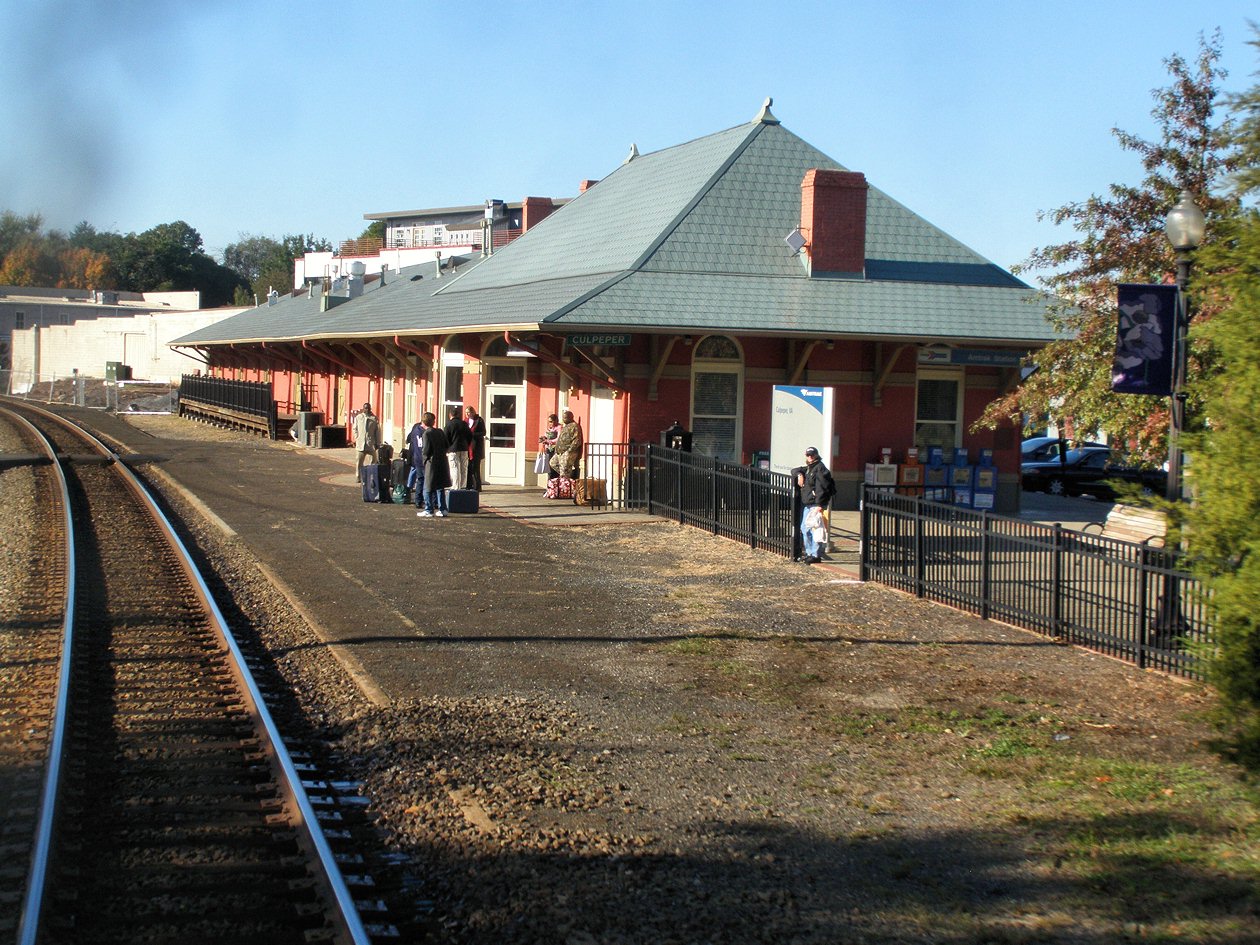 CULPEPER is a town of 9,600 that has grown rapidly into a “bedroom community” of Northern Virginia and its Washington suburbs. During the Civil War, it was an important crossroads for a number of armies marching through central Virginia, both Union and Confederate. In the heart of downtown stands the childhood home of Confederate General A.P. Hill, commander of “Hill’s Light Division” under Stonewall Jackson. During the Revolutionary War, the Culpeper Minutemen militia was formed here.
CULPEPER is a town of 9,600 that has grown rapidly into a “bedroom community” of Northern Virginia and its Washington suburbs. During the Civil War, it was an important crossroads for a number of armies marching through central Virginia, both Union and Confederate. In the heart of downtown stands the childhood home of Confederate General A.P. Hill, commander of “Hill’s Light Division” under Stonewall Jackson. During the Revolutionary War, the Culpeper Minutemen militia was formed here. Rapidan River, one of America’s best trout fishing streams, is the largest tributary of the Rappahannock River in North-central Virginia.
Rapidan River, one of America’s best trout fishing streams, is the largest tributary of the Rappahannock River in North-central Virginia.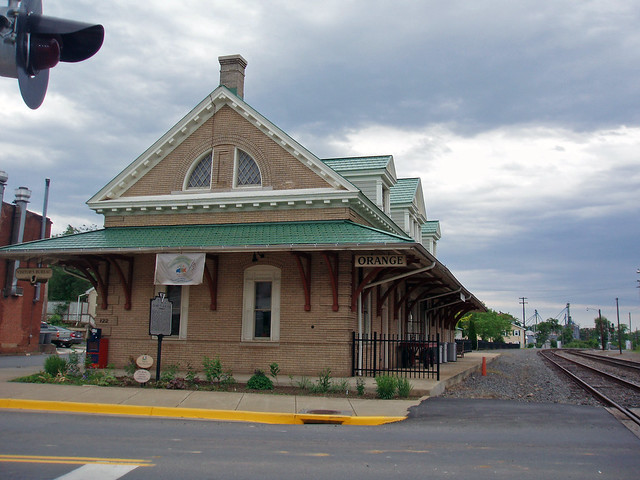 Orange served as General Robert E. Lee’s headquarters during the Civil War between 1862 and 1864 and was, being just north of the Rapidan River, effectively the northern border of the Confederacy at that time. The St. Thomas Episcopal Church, which still stands, was converted into a hospital for Confederate wounded after the Battles of Chancellorsville and Wilderness. Thriving well into the 20th century, the town became known for its silk mill, producing many of the parachutes used during World War II by U.S. troops. That building today houses a restaurant and other businesses. Actor Randolph Scott, best known for his “tall-in-thesaddle”western movie roles, was born in Orange County.
Orange served as General Robert E. Lee’s headquarters during the Civil War between 1862 and 1864 and was, being just north of the Rapidan River, effectively the northern border of the Confederacy at that time. The St. Thomas Episcopal Church, which still stands, was converted into a hospital for Confederate wounded after the Battles of Chancellorsville and Wilderness. Thriving well into the 20th century, the town became known for its silk mill, producing many of the parachutes used during World War II by U.S. troops. That building today houses a restaurant and other businesses. Actor Randolph Scott, best known for his “tall-in-thesaddle”western movie roles, was born in Orange County.  Gordonsville began
with a tavern operated from the late 1700s by Nathaniel Gordon catering to
stagecoach passengers en route. It hosted such notables as George
Washington, Thomas Jefferson and James Monroe. The town was of vital
importance to the Confederacy during the Civil War as a railroad junction
and was successfully defended on several occasions.
Gordonsville began
with a tavern operated from the late 1700s by Nathaniel Gordon catering to
stagecoach passengers en route. It hosted such notables as George
Washington, Thomas Jefferson and James Monroe. The town was of vital
importance to the Confederacy during the Civil War as a railroad junction
and was successfully defended on several occasions.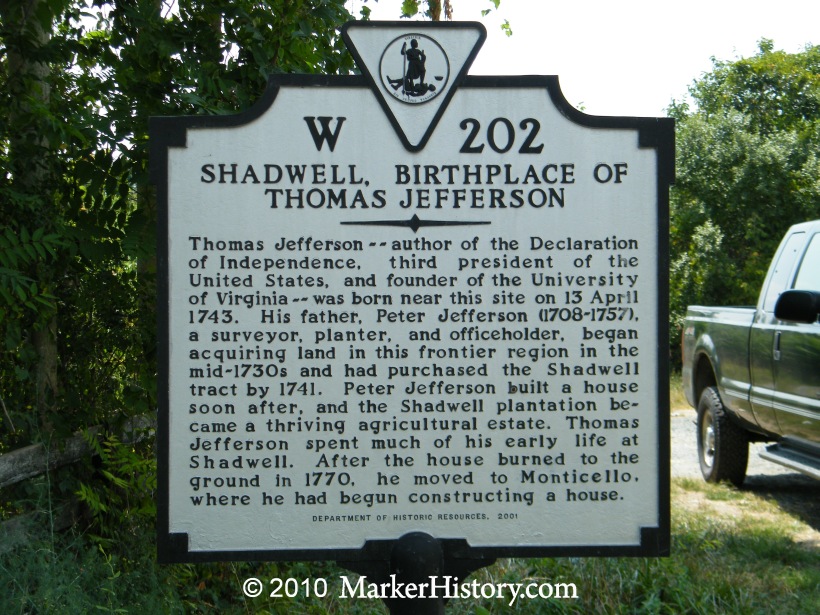 Shadwell is
the birthplace of Thomas Jefferson on a plantation of the same name; he
was one of six children. The original house burned to the ground in 1770.
By 1835, a carding factory that prepared raw fibers as textiles, a
merchant mill and a sawmill had sprung up and the town prospered. By the
time the railroad reached Shadwell in 1849, it had become one of the
earliest towns to have a station agent.
Shadwell is
the birthplace of Thomas Jefferson on a plantation of the same name; he
was one of six children. The original house burned to the ground in 1770.
By 1835, a carding factory that prepared raw fibers as textiles, a
merchant mill and a sawmill had sprung up and the town prospered. By the
time the railroad reached Shadwell in 1849, it had become one of the
earliest towns to have a station agent.  CHARLOTTESVILLE has been named best place to live in the U.S. based on cost of living, climate and quality of life. It is home to three former presidents: Thomas Jefferson, James Madison and James Monroe. It is also home to the University of Virginia, and Monticello, Jefferson’s renowned mountain-top
home. Nearby Michie Tavern was established in 1784 to serve as a social
center and provide travelers with food, drink and lodging. A Virginia
Historic Landmark, it remains in operation today offering tours, period
games, colonial reel dancing and 18th century-style dining. The town was
undamaged during the Civil War, surrendered by the mayor to spare it from
burning. Nearby Shenandoah National Park and Skyline Drive offer
recreational activities and beautiful scenery. Its Downtown Mall is one of
the longest outdoor pedestrian malls in the country. Actress Sissy Spacek,
actor Dwayne “The Rock” Johnson and novelist John Grisham have all
called Charlottesville home.
CHARLOTTESVILLE has been named best place to live in the U.S. based on cost of living, climate and quality of life. It is home to three former presidents: Thomas Jefferson, James Madison and James Monroe. It is also home to the University of Virginia, and Monticello, Jefferson’s renowned mountain-top
home. Nearby Michie Tavern was established in 1784 to serve as a social
center and provide travelers with food, drink and lodging. A Virginia
Historic Landmark, it remains in operation today offering tours, period
games, colonial reel dancing and 18th century-style dining. The town was
undamaged during the Civil War, surrendered by the mayor to spare it from
burning. Nearby Shenandoah National Park and Skyline Drive offer
recreational activities and beautiful scenery. Its Downtown Mall is one of
the longest outdoor pedestrian malls in the country. Actress Sissy Spacek,
actor Dwayne “The Rock” Johnson and novelist John Grisham have all
called Charlottesville home. STAUNTON was named after Lady Rebecca Staunton, wife of a popular
Colonial Governor. Founded in 1747, it was, in 1908, the first city in the
world to adopt a city manager form of government. Its appeal to tourism is
enhanced by the American Shakespeare Center, the Woodrow Wilson Presidential Library and birthplace and the Museum of American Frontier Culture. Its strict building codes make it an attractive location f r
period films; in 2006, scenes from the movie Evan Almighty were shot here.
The Statler Brothers, a country music group, launched their careers in
1955 at the Lynhurst Methodist Church.
STAUNTON was named after Lady Rebecca Staunton, wife of a popular
Colonial Governor. Founded in 1747, it was, in 1908, the first city in the
world to adopt a city manager form of government. Its appeal to tourism is
enhanced by the American Shakespeare Center, the Woodrow Wilson Presidential Library and birthplace and the Museum of American Frontier Culture. Its strict building codes make it an attractive location f r
period films; in 2006, scenes from the movie Evan Almighty were shot here.
The Statler Brothers, a country music group, launched their careers in
1955 at the Lynhurst Methodist Church. CLIFTON FORGE is the closest station to Hot Springs, home of the legendary
Homestead resort hotel situated in the heart of the Allegheny Mountains.
It features championship golf courses, horseback and carriage rides,
shooting, fly fishing, hiking, falconry, swimming and luxury
accommodations.
CLIFTON FORGE is the closest station to Hot Springs, home of the legendary
Homestead resort hotel situated in the heart of the Allegheny Mountains.
It features championship golf courses, horseback and carriage rides,
shooting, fly fishing, hiking, falconry, swimming and luxury
accommodations.Virginia/West Virginia State Line
Allegheny Tunnel The former Chesapeake & Ohio (C&O) and Virginia Central railroads traversed this mountainous region over a large portion of both main and branch lines; tunneling was necessary, and many survive in some form today. Leaving Clifton Forge, assault on the Allegheny Mountains required several tunnels. The Allegheny Tunnel runs under their crest and marks the boundary between Virginia and West Virginia, as well as the Eastern Continental Divide.
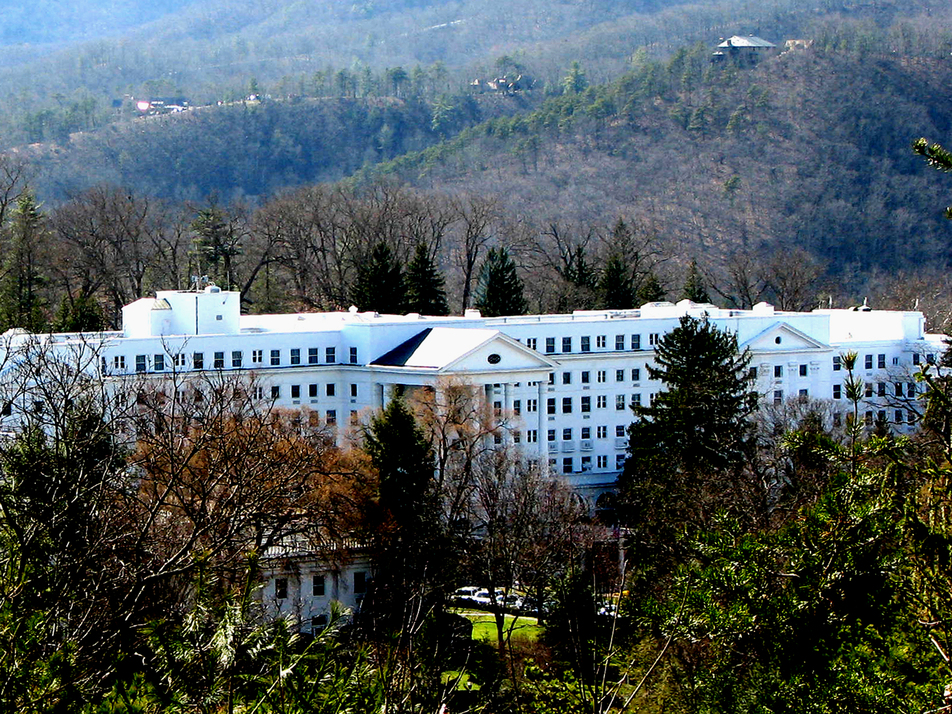 WHITE SULPHUR SPRINGS is the birthplace of golf in America; Oakhurst Links opened in 1884. The famous Greenbrier resort is one of the most
luxurious and exclusive resorts in the U.S. In 1979, it hosted the first
Ryder Cup featuring the current competitive setup of the U.S. and European
sides. The Greenbrier began as the “Queen of the Watering Places” and was
the summer destination of wealthy guests from all over the South. For much
of its history, it was owned by the former Chesapeake & Ohio Railway. Every U.S.
president from Dwight Eisenhower through George W. Bush has stayed at its
presidential suite.
WHITE SULPHUR SPRINGS is the birthplace of golf in America; Oakhurst Links opened in 1884. The famous Greenbrier resort is one of the most
luxurious and exclusive resorts in the U.S. In 1979, it hosted the first
Ryder Cup featuring the current competitive setup of the U.S. and European
sides. The Greenbrier began as the “Queen of the Watering Places” and was
the summer destination of wealthy guests from all over the South. For much
of its history, it was owned by the former Chesapeake & Ohio Railway. Every U.S.
president from Dwight Eisenhower through George W. Bush has stayed at its
presidential suite. ALDERSON is located along the Greenbrier River with a
population of about 1,100. The town boasts the largest Fourth of July
celebration in the state of West Virginia, with events spanning an entire
week. The station, in the historic downtown district, dates from 1896 and is
a recently restored example of depots typical of the standard C&O designs
used between 1890 and 1916. The town is also home to the Alderson Federal Prison Camp for minimum-security female inmates. It has housed such
notables as jazz singer and songwriter Billie Holiday, former MansonFamily member Lynette “Squeaky” Fromme and television host, author and
publisher Martha Stewart. Great Bend Tunnel under Big Bend Mountain
derives its fame from the story of John Henry besting the steam drill. The
six foot, 200 lb. Henry is said to have driven steel into hard rock --
with a hammer in each hand -- faster than could be done by the machine. A
song about his exploits became the most famous, widespread, widely
imitated and discussed folksongs in American railroading.
ALDERSON is located along the Greenbrier River with a
population of about 1,100. The town boasts the largest Fourth of July
celebration in the state of West Virginia, with events spanning an entire
week. The station, in the historic downtown district, dates from 1896 and is
a recently restored example of depots typical of the standard C&O designs
used between 1890 and 1916. The town is also home to the Alderson Federal Prison Camp for minimum-security female inmates. It has housed such
notables as jazz singer and songwriter Billie Holiday, former MansonFamily member Lynette “Squeaky” Fromme and television host, author and
publisher Martha Stewart. Great Bend Tunnel under Big Bend Mountain
derives its fame from the story of John Henry besting the steam drill. The
six foot, 200 lb. Henry is said to have driven steel into hard rock --
with a hammer in each hand -- faster than could be done by the machine. A
song about his exploits became the most famous, widespread, widely
imitated and discussed folksongs in American railroading. HINTON is a county seat featuring a complete downtown on the National
Registry of Historic Places. The Wood Clock Museum has over 500 clocks of
every type in a private collection that has been opened to the public, and
the Hinton Railroad Museum is filled with artifacts from the early days of
the C&O Railway.
HINTON is a county seat featuring a complete downtown on the National
Registry of Historic Places. The Wood Clock Museum has over 500 clocks of
every type in a private collection that has been opened to the public, and
the Hinton Railroad Museum is filled with artifacts from the early days of
the C&O Railway. 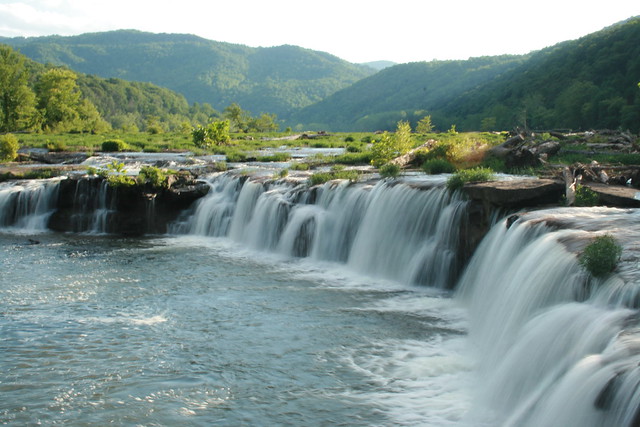 Sandstone Falls is a photographic spectacle and one of the Seven Natural
Wonders of West Virginia, created by continuous flats of sandstone
extending upstream some 12 miles of the New River Gorge National River.
Waders enjoy bath-temperature waters by spring as the falls flow over
broad rock surfaces.
Sandstone Falls is a photographic spectacle and one of the Seven Natural
Wonders of West Virginia, created by continuous flats of sandstone
extending upstream some 12 miles of the New River Gorge National River.
Waders enjoy bath-temperature waters by spring as the falls flow over
broad rock surfaces.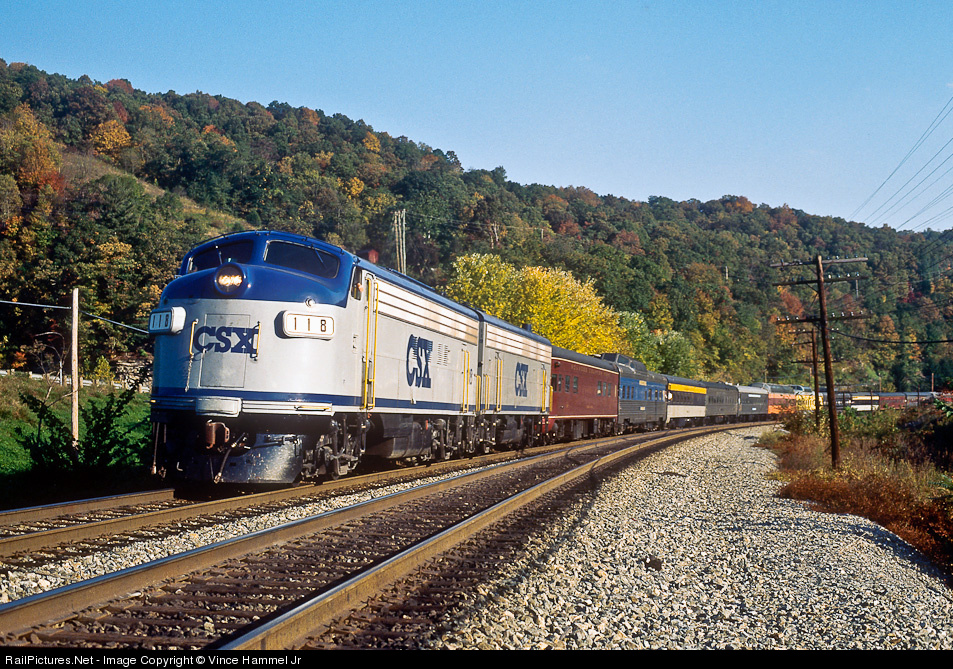 Sandstone is an unincorporated community and site of the
Sandstone Visitors Center built by the National Park Service to provide
outreach and build environmental awareness of issues involving the New
River George. Its interactive museum draws thousands of visitors annually. The
area contains some of the oldest prehistoric Native American artifacts yet to
be discovered. A nearby quarry contributed to the building of the
Washington Monument.
Sandstone is an unincorporated community and site of the
Sandstone Visitors Center built by the National Park Service to provide
outreach and build environmental awareness of issues involving the New
River George. Its interactive museum draws thousands of visitors annually. The
area contains some of the oldest prehistoric Native American artifacts yet to
be discovered. A nearby quarry contributed to the building of the
Washington Monument. PRINCE is located on an elevated portion of land upstream of
the railroad bridge near highway 41, one of the few auto routes crossing the
New River Gorge. The station is an acclaimed example of the Art Moderne
architectural style applied to a railroad structure. The C&O established
a station in Prince in 1880. The community’s founder, William Prince,
became involved in the coal business in the 1890s as coal was transported
across the New River to the opposite bank in buckets suspended on a wire
cable. Today, parts of the town have been protected by the National Park
Service. Three camping areas offer visitors hiking, biking, kayaking and
float-fishing – which suspends bait at a predetermined depth and signals a
bite.
PRINCE is located on an elevated portion of land upstream of
the railroad bridge near highway 41, one of the few auto routes crossing the
New River Gorge. The station is an acclaimed example of the Art Moderne
architectural style applied to a railroad structure. The C&O established
a station in Prince in 1880. The community’s founder, William Prince,
became involved in the coal business in the 1890s as coal was transported
across the New River to the opposite bank in buckets suspended on a wire
cable. Today, parts of the town have been protected by the National Park
Service. Three camping areas offer visitors hiking, biking, kayaking and
float-fishing – which suspends bait at a predetermined depth and signals a
bite. THURMOND was once a prosperous town during the heyday of coal mining
in the New River Gorge. Today, it is a town of seven residents – six of
whom sought elective office during the city elections held in 2005. It
served as the filming location of a 1987 movie starring James Earl Jones,
Matewan, depicting a 1920 miners strike and attempts to unionize workers.
Much of the Thurmond is owned by the National Park Service, and the entire
town is a designated historic district. The two story wooden structure
that houses the Amtrak station also contains a railroad museum and New
River Gorge visitor center.
THURMOND was once a prosperous town during the heyday of coal mining
in the New River Gorge. Today, it is a town of seven residents – six of
whom sought elective office during the city elections held in 2005. It
served as the filming location of a 1987 movie starring James Earl Jones,
Matewan, depicting a 1920 miners strike and attempts to unionize workers.
Much of the Thurmond is owned by the National Park Service, and the entire
town is a designated historic district. The two story wooden structure
that houses the Amtrak station also contains a railroad museum and New
River Gorge visitor center. 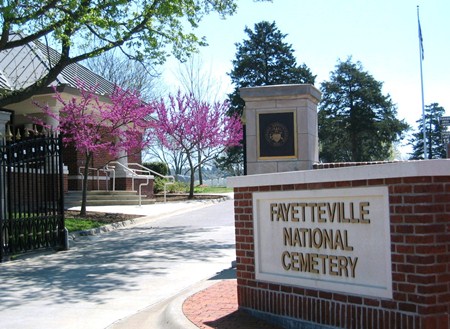 Fayetteville is situated on a plateau at an altitude of 1,820 ft.,
known as a mecca for world-class outdoor recreation as well as for the New River Gorge Bridge. Spanning 3,030 ft. at a height of 876 ft. above the New
River, it is the highest bridge in the Americas and second highest in the
world. The annual Bridge Day Festival in October hosts base jumpers
parachuting from the side of the bridge. The Fayetteville County
Courthouse, built in 1897, is a remarkable example of Romanesque Revival
architecture.
Fayetteville is situated on a plateau at an altitude of 1,820 ft.,
known as a mecca for world-class outdoor recreation as well as for the New River Gorge Bridge. Spanning 3,030 ft. at a height of 876 ft. above the New
River, it is the highest bridge in the Americas and second highest in the
world. The annual Bridge Day Festival in October hosts base jumpers
parachuting from the side of the bridge. The Fayetteville County
Courthouse, built in 1897, is a remarkable example of Romanesque Revival
architecture.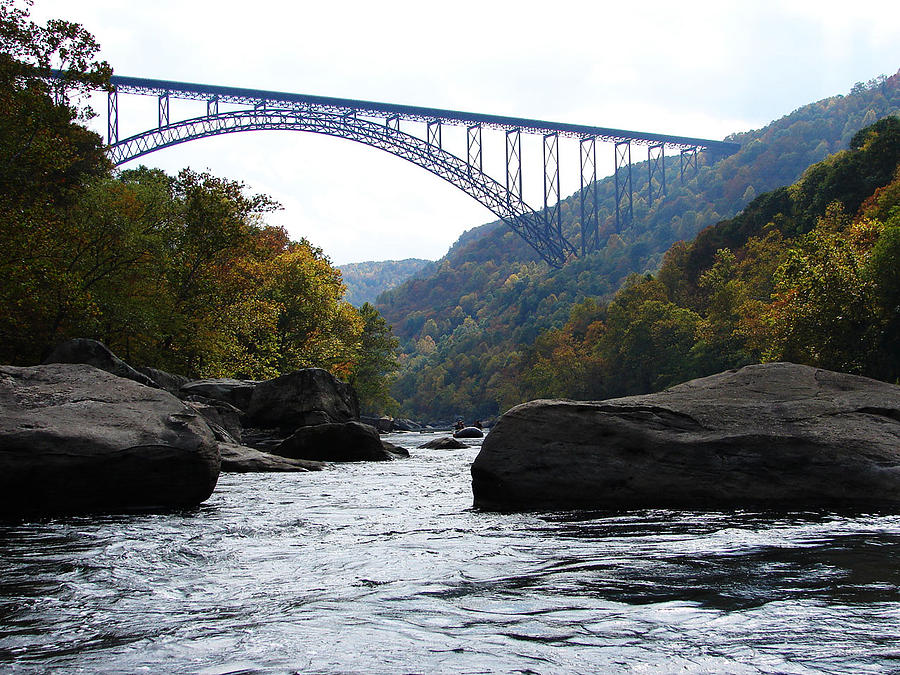 The New River Gorge is the site of some of the country’s best white water
rafting and has more than 1,400 established rock climbs. A national park system
unit, the New River Gorge National River is predated in geological history only
by the Nile in Egypt. It lies at the core of a significant forest containing
diverse flora, and provides habitat for endangered mammals, rare birds and
amphibians. Within the gorge lie a significant number of abandoned sites where
18th and 19th century people lived and worked to contribute the coal and lumber
that powered American industry of the day. The region was opened to the outside
world in 1872 with the coming of the railroad. Today, the river’s rapids draw
thrill seekers from everywhere.
The New River Gorge is the site of some of the country’s best white water
rafting and has more than 1,400 established rock climbs. A national park system
unit, the New River Gorge National River is predated in geological history only
by the Nile in Egypt. It lies at the core of a significant forest containing
diverse flora, and provides habitat for endangered mammals, rare birds and
amphibians. Within the gorge lie a significant number of abandoned sites where
18th and 19th century people lived and worked to contribute the coal and lumber
that powered American industry of the day. The region was opened to the outside
world in 1872 with the coming of the railroad. Today, the river’s rapids draw
thrill seekers from everywhere. Hawk’s Nest overlook, visible above and across the basin, offers spectacular views in
spring and fall of one of the most photographed vistas in the eastern U.S. The
State Park of the same name protects 270 acres on the northern rim of the New
River. It features a lodge with 31 rooms, aerial tram, museum and the overlook,
in addition to hiking, biking, paddle boating and fishing. Its stone buildings
were built by the Civilian Conservation Corps in the 1930s and are of interest to
historians. A project to dam the river at Hawk’s Nest in 1927 cost many workers
their lives when the mineral silica was discovered during construction of a
tunnel. Exposure to the dust led to lung disease and spurred government efforts
to improve worker safety. The name derived from the fish hawks that originally
inhabited the massive cliffs. They left the site permanently after the
railroads began blasting in the area between 1869 and 1873.
Hawk’s Nest overlook, visible above and across the basin, offers spectacular views in
spring and fall of one of the most photographed vistas in the eastern U.S. The
State Park of the same name protects 270 acres on the northern rim of the New
River. It features a lodge with 31 rooms, aerial tram, museum and the overlook,
in addition to hiking, biking, paddle boating and fishing. Its stone buildings
were built by the Civilian Conservation Corps in the 1930s and are of interest to
historians. A project to dam the river at Hawk’s Nest in 1927 cost many workers
their lives when the mineral silica was discovered during construction of a
tunnel. Exposure to the dust led to lung disease and spurred government efforts
to improve worker safety. The name derived from the fish hawks that originally
inhabited the massive cliffs. They left the site permanently after the
railroads began blasting in the area between 1869 and 1873. Gauley Bridge marks
the confluence of the New and Gauley Rivers to form the Kanawha River.
Throughout this wild and beautifully picturesque country, much is visible only
by rail or whitewater raft.
Gauley Bridge marks
the confluence of the New and Gauley Rivers to form the Kanawha River.
Throughout this wild and beautifully picturesque country, much is visible only
by rail or whitewater raft. MONTGOMERY is home to the West Virginia University Institute of
MONTGOMERY is home to the West Virginia University Institute of
Technology. A 1993 television film, “Goodbye Miss 4th of July,” depicting the story of a Greek family growing up in Montgomery, was produced by the Disney Channel. The town takes its name from one of the city’s first settlers, James C. Montgomery.
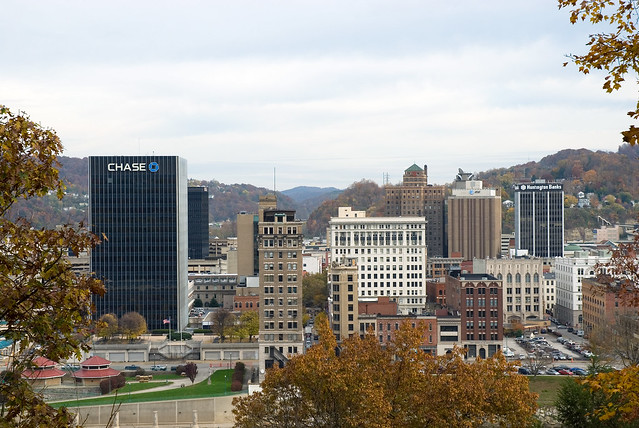 CHARLESTON is the largest city in, and the capital of, West Virginia, situated at the confluence of the Elk and Kanawha Rivers. The gold domed capitol building visible from the train was completed in 1932. Before the state of West Virginia was admitted to the Union in 1863, Charleston, established in 1794, was part of Virginia. By the early 1800s, salt brines were discovered along the Kanawha River and the first salt well was drilled, bringing prosperity and economic growth. Citizens chose the city as their state capital in 1877. In the 20th century, natural resources such as coal and natural gas, railroad expansion and state government all contributed to growth. Annual events include the West Virginia Dance Festival and the West Virginia International Film Festival. Actress Jennifer Garner and country singer Kathy Mattea grew up here.
CHARLESTON is the largest city in, and the capital of, West Virginia, situated at the confluence of the Elk and Kanawha Rivers. The gold domed capitol building visible from the train was completed in 1932. Before the state of West Virginia was admitted to the Union in 1863, Charleston, established in 1794, was part of Virginia. By the early 1800s, salt brines were discovered along the Kanawha River and the first salt well was drilled, bringing prosperity and economic growth. Citizens chose the city as their state capital in 1877. In the 20th century, natural resources such as coal and natural gas, railroad expansion and state government all contributed to growth. Annual events include the West Virginia Dance Festival and the West Virginia International Film Festival. Actress Jennifer Garner and country singer Kathy Mattea grew up here. HUNTINGTON is West Virginia’s second largest city on the border of Ohio along the Ohio River, founded in 1870 as the western terminus for the Chesapeake and Ohio Railway. Today, Marshall University occupies a large portion of the city to the east of the Central Business District and was named in honor of former U.S. Supreme Court Justice John Marshall. Among its earlier graduates was Carter G. Woodson, who became the Father of Afro-American History when he founded Negro History Week in 1926. It later became Afro-American History Month. After the prominence of coal mining waned, the city became a regional medical community and a university town. The city hosts several annual events including Jazz-MU-Tazz at the University. Hollywood Squares host Peter Marshall and the late comedian Soupy Sales grew up here.
HUNTINGTON is West Virginia’s second largest city on the border of Ohio along the Ohio River, founded in 1870 as the western terminus for the Chesapeake and Ohio Railway. Today, Marshall University occupies a large portion of the city to the east of the Central Business District and was named in honor of former U.S. Supreme Court Justice John Marshall. Among its earlier graduates was Carter G. Woodson, who became the Father of Afro-American History when he founded Negro History Week in 1926. It later became Afro-American History Month. After the prominence of coal mining waned, the city became a regional medical community and a university town. The city hosts several annual events including Jazz-MU-Tazz at the University. Hollywood Squares host Peter Marshall and the late comedian Soupy Sales grew up here.
West Virginia/Kentucky State Line
 Ohio River Also known as Big Sandy River, it is a tributary of the Mississippi and carries commercial shipping including coal mined in the region. The name is derived from the presence of extensive sand bars.
Ohio River Also known as Big Sandy River, it is a tributary of the Mississippi and carries commercial shipping including coal mined in the region. The name is derived from the presence of extensive sand bars. ASHLAND is an economic and medical center for northeastern Kentucky.
Its early growth was fueled by the pig iron industry, and later on by coal and
other industrial concerns. The business district includes the Paramount Arts
center where Billy Ray Cyrus’ music video Achy Breaky Heart was taped. The city
boasts a 47-acre wooded Central Park hosting an annual holiday light show; a
street in the park, Chuck Woolery Boulevard, is named for the well-known game
show host who hails from Ashland. Notable natives also include the Judds, a
country music duo, and actress Ashley Judd; Judd Plaza is named in their honor.
Russell is located on hilly topography and founded as a good strategic position
against attacks by local Native American tribes. AK Steel’s Ashland Works is
located here, as is a large CSX Transportation rail classification yard.
Country singer Billy Ray Cyrus attended high school in Russell.
ASHLAND is an economic and medical center for northeastern Kentucky.
Its early growth was fueled by the pig iron industry, and later on by coal and
other industrial concerns. The business district includes the Paramount Arts
center where Billy Ray Cyrus’ music video Achy Breaky Heart was taped. The city
boasts a 47-acre wooded Central Park hosting an annual holiday light show; a
street in the park, Chuck Woolery Boulevard, is named for the well-known game
show host who hails from Ashland. Notable natives also include the Judds, a
country music duo, and actress Ashley Judd; Judd Plaza is named in their honor.
Russell is located on hilly topography and founded as a good strategic position
against attacks by local Native American tribes. AK Steel’s Ashland Works is
located here, as is a large CSX Transportation rail classification yard.
Country singer Billy Ray Cyrus attended high school in Russell.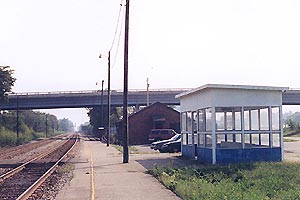 SOUTH SHORE/SOUTH PORTSMOUTH is situated along the Ohio River across from Portsmouth, Ohio. Former major league pitcher and coach Don Gullett is from South Shore.
SOUTH SHORE/SOUTH PORTSMOUTH is situated along the Ohio River across from Portsmouth, Ohio. Former major league pitcher and coach Don Gullett is from South Shore. MAYSVILLE
is an historically important town in the Kentucky bluegrass region, settled by frontiersmen like Daniel Boone. Once a center of wrought iron manufacture, it sent fancy ironwork to New Orleans to decorate its buildings. For a large part of the 20th century, it was home to one of the largest tobacco auction warehouse systems in the world. Seen from above at night, the streetlights of the downtown area form the outline of the Liberty Bell, including its crack. The late singer and actress Rosemary Clooney was born here.
MAYSVILLE
is an historically important town in the Kentucky bluegrass region, settled by frontiersmen like Daniel Boone. Once a center of wrought iron manufacture, it sent fancy ironwork to New Orleans to decorate its buildings. For a large part of the 20th century, it was home to one of the largest tobacco auction warehouse systems in the world. Seen from above at night, the streetlights of the downtown area form the outline of the Liberty Bell, including its crack. The late singer and actress Rosemary Clooney was born here.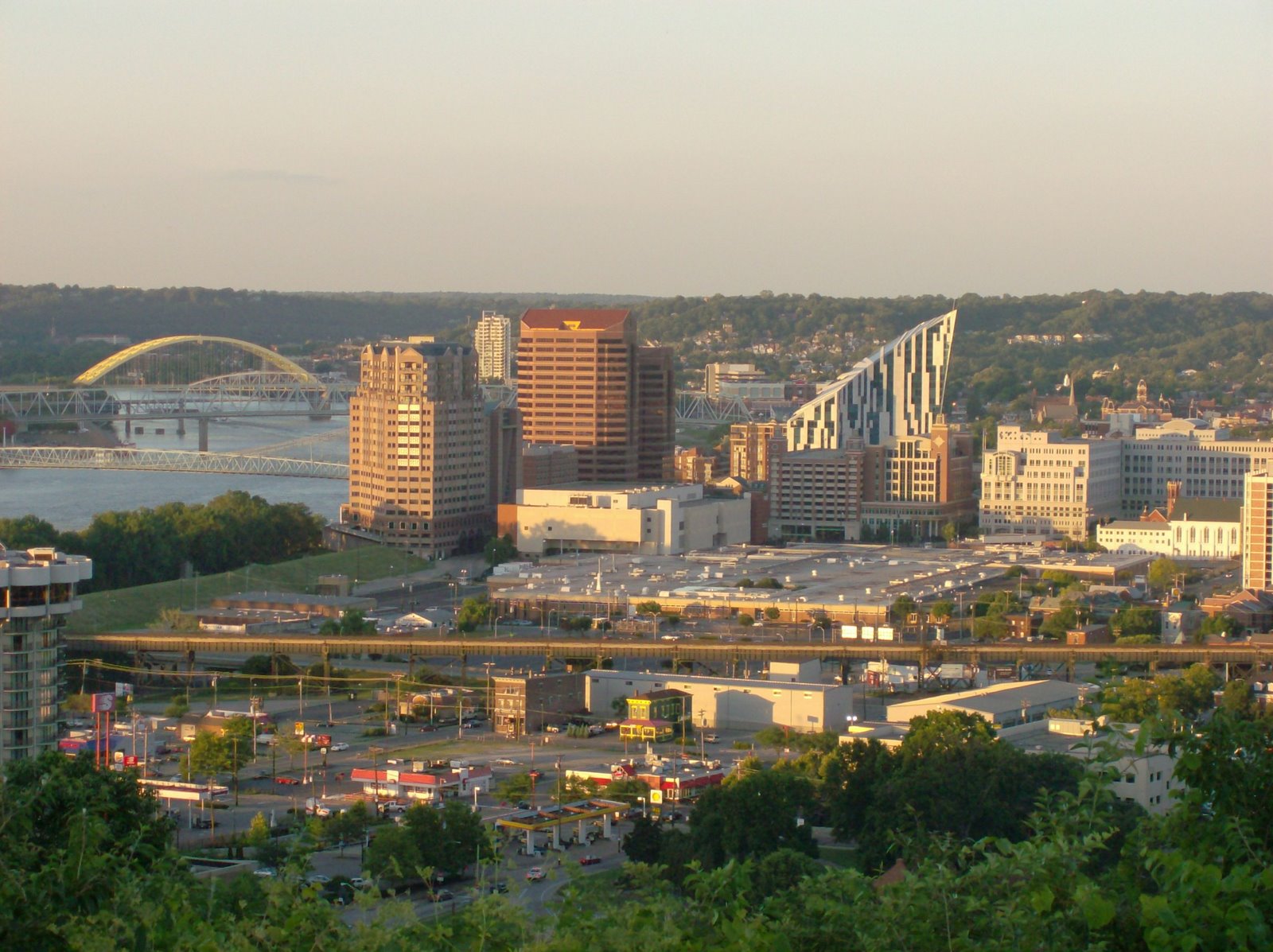 COVINGTON Here, just outside of Cincinnati, we again cross the Ohio
River. Originally called Fort Rowdy, Covington’s annual October gathering
celebrates the village’s beginnings as a fort built in 1793 by the forces of
“Mad Anthony” Wayne. The American general defeated an Indian confederacy and
signed the Treaty of Greenville, giving most of what is present-day Ohio to the
U.S. and clearing the way for statehood in 1803. “Rowdy” was what Wayne dubbed
the fort because of the carousing his officers and men embarked upon after
building the breastworks of brush and logs at the site. A museum features Civil
War exhibits and displays related to the town’s history.
COVINGTON Here, just outside of Cincinnati, we again cross the Ohio
River. Originally called Fort Rowdy, Covington’s annual October gathering
celebrates the village’s beginnings as a fort built in 1793 by the forces of
“Mad Anthony” Wayne. The American general defeated an Indian confederacy and
signed the Treaty of Greenville, giving most of what is present-day Ohio to the
U.S. and clearing the way for statehood in 1803. “Rowdy” was what Wayne dubbed
the fort because of the carousing his officers and men embarked upon after
building the breastworks of brush and logs at the site. A museum features Civil
War exhibits and displays related to the town’s history.
Kentucky/Ohio State Line
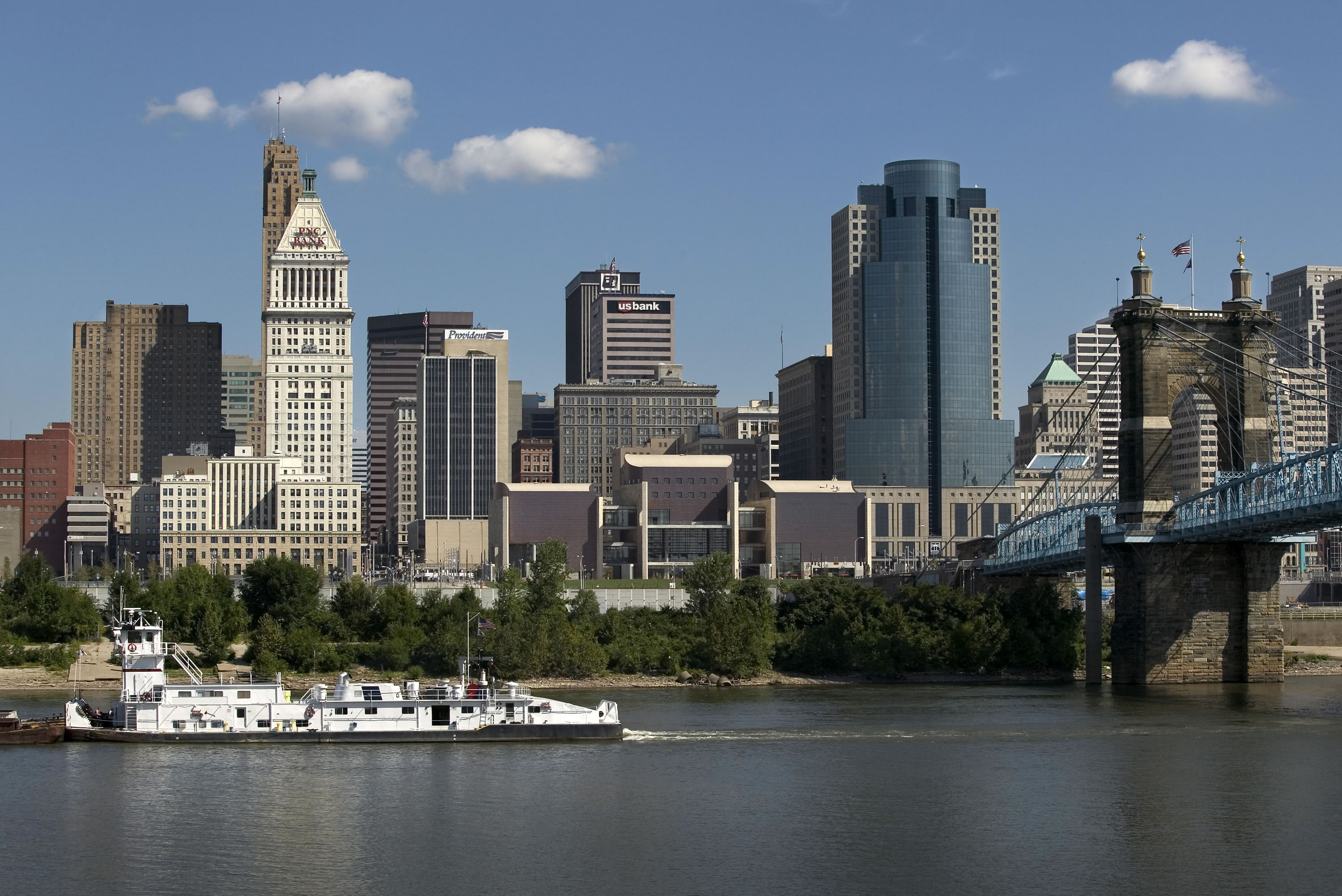 CINCINNATI was founded in 1788 and named after the Society of Cincinnati. It honors George Washington, who was considered a latter-day Cincinnatus – a Roman called to serve as dictator who immediately resigned his authority after successfully concluding a crisis. It was considered the first “boomtown” in the
heart of the country to rival coastal cities. Steam navigation on the Ohio River helped grow Cincinnati, along with construction of a canal. Rapid expansion followed, and the railroad appeared in 1836. Cincinnati was first in the world to use steam fire engines, and first in the U.S. to establish a paid fire department. The precursor to baseball’s Cincinnati Reds began as the Red Stockings in 1869, the first professional baseball team in the country.
Proctor & Gamble introduced Ivory Soap here in 1879. Today, the downtown area is focused around Fountain Square. Union Terminal, built in 1933, houses a Museum Center and Omnimax Theater. The city is home to ten Fortune 500 companies. Its Oktoberfest is the largest such celebration in the country. Its range of unique foods includes several varieties of chili, and goetta, a peasant food of German origin composed of ground beef and oats, commonly consumed as a breakfast meat. Many movies and TV shows have been shot or set in Cincinnati, such as Batman Forever and WKRP in Cincinnati. In 1911, Leonard Slye was born in Cincinnati in a house where second base now sits at Riverfront Stadium. He was destined to become better known as Roy Rogers, the King of the Cowboys.
CINCINNATI was founded in 1788 and named after the Society of Cincinnati. It honors George Washington, who was considered a latter-day Cincinnatus – a Roman called to serve as dictator who immediately resigned his authority after successfully concluding a crisis. It was considered the first “boomtown” in the
heart of the country to rival coastal cities. Steam navigation on the Ohio River helped grow Cincinnati, along with construction of a canal. Rapid expansion followed, and the railroad appeared in 1836. Cincinnati was first in the world to use steam fire engines, and first in the U.S. to establish a paid fire department. The precursor to baseball’s Cincinnati Reds began as the Red Stockings in 1869, the first professional baseball team in the country.
Proctor & Gamble introduced Ivory Soap here in 1879. Today, the downtown area is focused around Fountain Square. Union Terminal, built in 1933, houses a Museum Center and Omnimax Theater. The city is home to ten Fortune 500 companies. Its Oktoberfest is the largest such celebration in the country. Its range of unique foods includes several varieties of chili, and goetta, a peasant food of German origin composed of ground beef and oats, commonly consumed as a breakfast meat. Many movies and TV shows have been shot or set in Cincinnati, such as Batman Forever and WKRP in Cincinnati. In 1911, Leonard Slye was born in Cincinnati in a house where second base now sits at Riverfront Stadium. He was destined to become better known as Roy Rogers, the King of the Cowboys.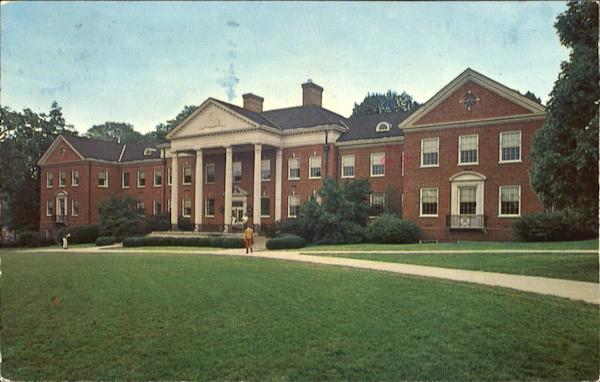 Oxford/MiamiUniversity was founded in 1809, highly ranked as a so-called “Public Ivy” for
its faculty, offerings and overall experience. Described by poet Robert Frost as “the most beautiful college there ever was,” it is one of only four colleges to produce both a U.S. President (Benjamin Harrison) and a Super Bowl-winning quarterback (Ben Rothlisberger). It is well known for its School of Education housed in McGuffey Hall, named after a Classics professor who wrote the pioneer text book McGuffey Reader. The book had at one time more than 130 million copies in print, more than any book in history, with the exception of the Bible.
Oxford/MiamiUniversity was founded in 1809, highly ranked as a so-called “Public Ivy” for
its faculty, offerings and overall experience. Described by poet Robert Frost as “the most beautiful college there ever was,” it is one of only four colleges to produce both a U.S. President (Benjamin Harrison) and a Super Bowl-winning quarterback (Ben Rothlisberger). It is well known for its School of Education housed in McGuffey Hall, named after a Classics professor who wrote the pioneer text book McGuffey Reader. The book had at one time more than 130 million copies in print, more than any book in history, with the exception of the Bible.
Ohio/Indiana State Line
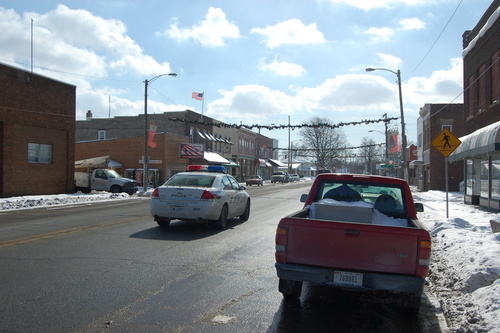 Liberty is a farming community and county seat most noted as the birthplace of Ambrose Burnside, the Civil War Union General whose unique facial whiskers gave rise to the modern term “sideburns.”
Liberty is a farming community and county seat most noted as the birthplace of Ambrose Burnside, the Civil War Union General whose unique facial whiskers gave rise to the modern term “sideburns.”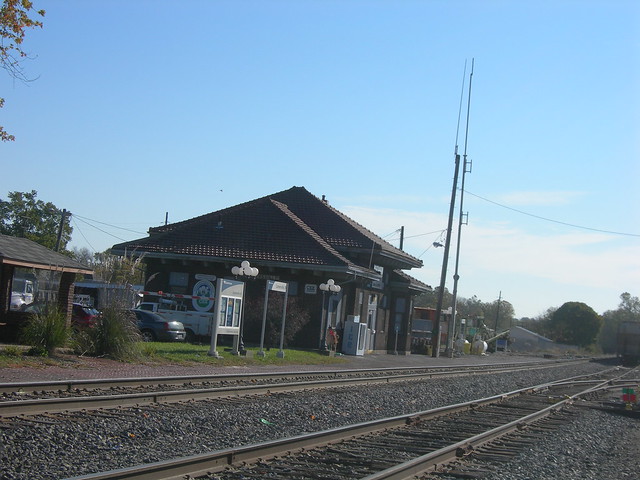
CONNERSVILLE was known in the early 20th century as “Little Detroit” for its importance to the auto industry. The McFarlan Motor Corporation produced cars here for 19 years; Auburn, Cord, Lexington and others also had production facilities. Al Capone is said to have purchase two McFarlans, one for himself and another for his wife. Several Duesenberg bodies were also produced here. Its American Central plant later built Jeep bodies for Willys Overland and Admiral kitchen appliances, making the city one of the largest dishwasher producers in the country. Connersville is home to both the first industrial park and the first high school band in the U.S. Each June, the Heritage MusicFest takes place at a campground by the Whitewater River, and the MudFest is celebrated each July.
 INDIANAPOLIS
is Indiana’s largest city and state capital, having the second largest number
of monuments after Washington, D.C. For much of its history, it has been
oriented to government and industry. Today, its economy is more diversified.
Its Indianapolis 500, a Memorial Day race for open-wheel cars, is the largest
single-day sporting event in the world with more than 257,000 permanent seats.
The city is also home to the
Colts of the NFL and the Pacers of the NBA. Residents and visitors enjoy the
Indiana State Fair and the Indy Jazz Festival annually. It is the second most
populous state capital after Phoenix, and the only one to occupy the exact
center of its state. City centeris Monument Circle featuring the Soldiers’ and
Sailors’ Monument. Kiwanis
International is headquartered here. The TV sitcom One Day at a Time was set in
Indianapolis, the opening credits of which included a shot of the Pyramids, a
set of three office buildings.
INDIANAPOLIS
is Indiana’s largest city and state capital, having the second largest number
of monuments after Washington, D.C. For much of its history, it has been
oriented to government and industry. Today, its economy is more diversified.
Its Indianapolis 500, a Memorial Day race for open-wheel cars, is the largest
single-day sporting event in the world with more than 257,000 permanent seats.
The city is also home to the
Colts of the NFL and the Pacers of the NBA. Residents and visitors enjoy the
Indiana State Fair and the Indy Jazz Festival annually. It is the second most
populous state capital after Phoenix, and the only one to occupy the exact
center of its state. City centeris Monument Circle featuring the Soldiers’ and
Sailors’ Monument. Kiwanis
International is headquartered here. The TV sitcom One Day at a Time was set in
Indianapolis, the opening credits of which included a shot of the Pyramids, a
set of three office buildings. CRAWFORDSVILLE held the first official intercollegiate basketball game at the YMCA between Wabash College and Purdue in 1894. Today, Wabash is one of only four remaining all-male liberal arts colleges in the U.S. One of the country’s first Rotary Jails opened here in 1882; now a museum, it is on the National Register of Historic Places. In 1891, appearance of the so-called “Crawfordsville Monster” in the skies above the city on two occasions frightened some 100 local citizens. The story was published in the Indianapolis Journal. An annual tour downtown addresses both the creature and other mysterious happenings that year.
CRAWFORDSVILLE held the first official intercollegiate basketball game at the YMCA between Wabash College and Purdue in 1894. Today, Wabash is one of only four remaining all-male liberal arts colleges in the U.S. One of the country’s first Rotary Jails opened here in 1882; now a museum, it is on the National Register of Historic Places. In 1891, appearance of the so-called “Crawfordsville Monster” in the skies above the city on two occasions frightened some 100 local citizens. The story was published in the Indianapolis Journal. An annual tour downtown addresses both the creature and other mysterious happenings that year.
 LAFAYETTE is
the county seat of Tippecanoe County and home to Purdue University, around
which revolve many of the industrial and economic activities of the city. Alcoa
Aluminum, Caterpillar Large Engine Division and Subaru of Indiana also maintain
a presence here. Its early regional prominence sprang from its function as a
shipping center on the Wabash River, further escalated by the arrival of the railroad
in the 1850s. In 1859, the country’s first official air mail delivery took
place when John Wise piloted a balloon from Lafayette to Crawfordsville.
Notable natives include the late director, producer and actor, Sydney Pollack;
the co-founder of Sears, Roebuck and Company, Alvah Curtis Roebuck; and the
founder and chief executive of public affairs television network C-SPAN, Brian
Lamb.
LAFAYETTE is
the county seat of Tippecanoe County and home to Purdue University, around
which revolve many of the industrial and economic activities of the city. Alcoa
Aluminum, Caterpillar Large Engine Division and Subaru of Indiana also maintain
a presence here. Its early regional prominence sprang from its function as a
shipping center on the Wabash River, further escalated by the arrival of the railroad
in the 1850s. In 1859, the country’s first official air mail delivery took
place when John Wise piloted a balloon from Lafayette to Crawfordsville.
Notable natives include the late director, producer and actor, Sydney Pollack;
the co-founder of Sears, Roebuck and Company, Alvah Curtis Roebuck; and the
founder and chief executive of public affairs television network C-SPAN, Brian
Lamb. Tippecanoe Battlefield Park is a wooded area seven miles north of Lafayette that played a
major role in American history. In 1811, the Battle of Tippecanoe between
American forces led by William Henry Harrison defeated an American Indian
confederation led by Tecumseh and his brother, Tenskwatawa, which dealt a
severe blow to the confederacy. The battle was used as a campaign slogan in the
election of 1840, “Tippecanoe and Tyler Too,” that helped Harrison win the Presidency
and John Tyler the Vice Presidency. The park offers hiking, a nature center, a
battlefield monument and a museum.
Tippecanoe Battlefield Park is a wooded area seven miles north of Lafayette that played a
major role in American history. In 1811, the Battle of Tippecanoe between
American forces led by William Henry Harrison defeated an American Indian
confederation led by Tecumseh and his brother, Tenskwatawa, which dealt a
severe blow to the confederacy. The battle was used as a campaign slogan in the
election of 1840, “Tippecanoe and Tyler Too,” that helped Harrison win the Presidency
and John Tyler the Vice Presidency. The park offers hiking, a nature center, a
battlefield monument and a museum.  RENSSELAER
was platted in 1839, named for founder James Van Rensselaer of Utica, New York.
St. Joseph’s College was established in 1888. It is today a primarily
undergraduate Catholic institution offering 75 major, minor and
pre-professional programs along with a nationally acclaimed Core Curriculum.
RENSSELAER
was platted in 1839, named for founder James Van Rensselaer of Utica, New York.
St. Joseph’s College was established in 1888. It is today a primarily
undergraduate Catholic institution offering 75 major, minor and
pre-professional programs along with a nationally acclaimed Core Curriculum.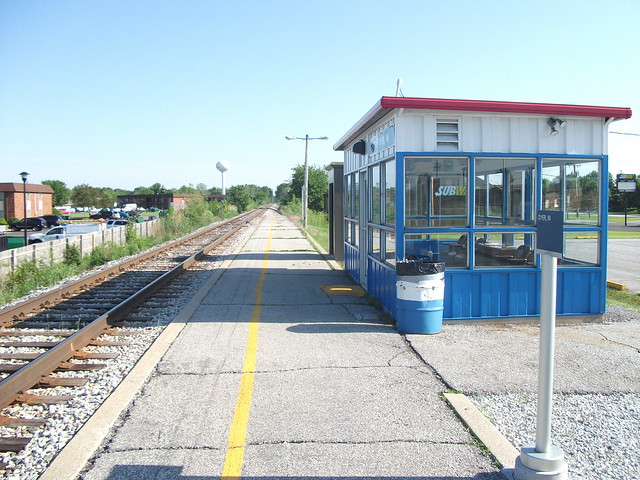 DYER forms
the border with the state of Illinois on its western side. In 2005, the town
was named one of the best places to live in the U.S. by CNN and Money Magazine.
It is also home to the Chi Town Shooters, a professional hockey team of the All
American Hockey League.
DYER forms
the border with the state of Illinois on its western side. In 2005, the town
was named one of the best places to live in the U.S. by CNN and Money Magazine.
It is also home to the Chi Town Shooters, a professional hockey team of the All
American Hockey League.
Indiana/Illinois
State Line
 CHICAGO
Vibrant and energetic, Chicago is the industrial core of the Midwest and a
major transportation hub. In the heart of America’s agriculture belt, it is a
leading distributor of farm products. Its many regional food specialties
reflect the city’s ethnic and working class roots. Its spirit is also
exemplified in its unique architecture; here is where the word “skyscraper”
originated in 1885. The arts and sciences are also alive here, with an
abundance of world-renowned theaters and museums. Cellular Field, home of the
Chicago White Sox, is soon visible. (As we cross the Rock Island Railroad at
Englewood, imagine the intense rivalry between the Twentieth Century and
Broadway Limited trains as they raced one another to New York decades ago.) Of
particular note is the New Regal Theater, originally an “atmospheric” motion
picture palace where
the audience sat in an imaginary courtyard under the stars. Today, it is a
showcase for live entertainment. The cemetery you see is where Harold
Washington, the city’s first African American mayor, is buried. We now cross
the South Branch of the Chicago River, famous for its backwards flow, and where
ships ply Great Lakes ports along the Illinois and Michigan Canal. Sanitary
engineers reversed its flow in the early 1900s to prevent epidemics. As we pull
into the covered platforms in the station, watch for an impressive view of the
city skyline. Among its magnificent structures are the Sears Tower, Daley Center and John Hancock Building. Most Amtrak long-distance trains originate or
terminate here.
CHICAGO
Vibrant and energetic, Chicago is the industrial core of the Midwest and a
major transportation hub. In the heart of America’s agriculture belt, it is a
leading distributor of farm products. Its many regional food specialties
reflect the city’s ethnic and working class roots. Its spirit is also
exemplified in its unique architecture; here is where the word “skyscraper”
originated in 1885. The arts and sciences are also alive here, with an
abundance of world-renowned theaters and museums. Cellular Field, home of the
Chicago White Sox, is soon visible. (As we cross the Rock Island Railroad at
Englewood, imagine the intense rivalry between the Twentieth Century and
Broadway Limited trains as they raced one another to New York decades ago.) Of
particular note is the New Regal Theater, originally an “atmospheric” motion
picture palace where
the audience sat in an imaginary courtyard under the stars. Today, it is a
showcase for live entertainment. The cemetery you see is where Harold
Washington, the city’s first African American mayor, is buried. We now cross
the South Branch of the Chicago River, famous for its backwards flow, and where
ships ply Great Lakes ports along the Illinois and Michigan Canal. Sanitary
engineers reversed its flow in the early 1900s to prevent epidemics. As we pull
into the covered platforms in the station, watch for an impressive view of the
city skyline. Among its magnificent structures are the Sears Tower, Daley Center and John Hancock Building. Most Amtrak long-distance trains originate or
terminate here.
No comments:
Post a Comment